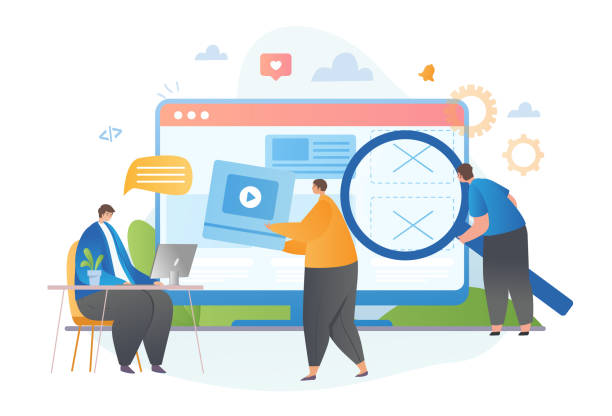What is Responsive Website Design? Understanding the Basics

In today’s world, where users access the internet from a variety of devices, #Responsive_Web_Design has become a necessity.
This design approach enables websites to automatically adapt to the screen size and resolution of the user’s device (from desktop to tablet and smartphone) without needing separate versions.
The main goal is to provide a unified and optimized #User_Experience for all visitors, regardless of the device they use.
This concept was introduced in 2010 by Ethan Marcotte and quickly became an industry standard.
Responsive Web Design is built on three fundamental principles: Fluid Grids, Flexible Images, and Media Queries.
These principles allow developers to adjust the layout, font sizes, and images to display optimally on any screen size.
This specialized approach is not only technically advanced but also has important educational aspects that help developers learn best practices for building future-compatible websites.
This is a comprehensive explanation of the fundamentals of responsive website design.
Does your current website turn visitors into customers or drive them away? Solve this problem forever with professional corporate website design by Rasawab!
✅ Create credibility and powerful branding
✅ Attract target customers and increase sales
⚡ Get a free consultation now!
Why is Responsive Website Design Crucial? Importance and Benefits

The importance of responsive website design is not limited to visual aesthetics but encompasses broader dimensions including performance, SEO, and user satisfaction.
In the current era, where more than half of web traffic comes from mobile devices, a website that is not properly responsive will lose a large portion of its audience.
One of the most important advantages of this approach is improved user experience (UX).
Users expect websites to load quickly and be easy to navigate, regardless of the device they use.
Responsive design ensures that content is displayed in a readable and structured manner, which in turn reduces bounce rates and increases user engagement.
Furthermore, responsive website design has a significant impact on SEO.
Google has clearly stated that it prefers mobile-friendly websites in its search results rankings.
Having a single URL for all devices instead of separate URLs (e.g., m.example.com) makes crawling and indexing easier for search engines and avoids duplicate content issues.
This is an important analysis that shows why this type of design is vital for any business.
These guidelines help website owners make better decisions and leverage its competitive advantages.
Key Elements in Responsive Website Design: Techniques and Tools

For successful implementation of responsive website design, understanding and utilizing several key elements is essential.
These elements form the backbone of any device-compatible website, allowing it to intelligently adapt to different environments.
The first and most important element is Media Queries.
These CSS commands allow designers to apply different styles based on device characteristics (such as screen width, height, orientation, and resolution).
For example, you can define rules that make the site’s layout on a mobile phone completely different from its layout on a desktop monitor.
The second element is Fluid Grids.
Instead of using fixed pixel dimensions, fluid grids use relative units like percentages for element widths.
This means that the width of a column, instead of being 100 pixels, can be 20% of the screen width, so that columns automatically resize as the screen size changes.
The third element is Flexible Images.
These images, using properties like max-width: 100% in CSS, ensure they never exceed their container and automatically adapt to the available space.
Finally, the Viewport Meta Tag is crucial for controlling browser scaling and page dimensions.
These specialized explanations are a foundation for any developer looking to build a responsive website.
The table below shows the key elements and their applications:
| Element | Description | Code Example (CSS) |
|---|---|---|
| Media Queries | Apply different styles based on device characteristics (e.g., screen width). |
|
| Fluid Grids | Use relative units (percentages) for element layout. |
|
| Flexible Images | Automatic resizing of images to prevent overflow. |
|
| Viewport Meta Tag | Control initial scaling and page dimensions. |
|
Mobile-First Approach in Responsive Website Design

The Mobile-First approach is a design philosophy increasingly adopted in the web community and is an ideal complement to responsive website design.
Instead of starting design for large desktop screens and then trying to adapt it for smaller devices, the mobile-first approach begins the design and development process with the smallest possible screen (mobile).
This means that you should first think about the essential elements and core content needed for the mobile user experience, and then gradually add features and complexities for larger screens.
This approach not only leads to websites that perform better on mobile devices but also helps improve loading speed.
When you design for mobile first, you are naturally driven towards optimizing resources, reducing file sizes, and prioritizing content, as screen space and bandwidth are more limited on mobile devices.
This, in turn, leads to lighter and more efficient code that benefits all devices.
Also, this approach helps you focus on minimalist design principles and core content, which can improve the overall user experience.
In terms of guidance, this is a key recommendation for any web developer looking to future-proof their projects.
Did you know that 94% of the first impression of a company is related to its website design?
Rasawab, by providing professional corporate website design services, helps you create the best first impression.
✅ Create a professional and trustworthy image for your brand
✅ Easily attract potential customers and improve online presence
⚡ Get a free corporate website design consultation!
Common Challenges and Problems in Implementing Responsive Design

Despite its many advantages, implementing responsive website design is not without its challenges.
Some common problems can complicate the development process and require precise and analytical solutions.
One of the biggest challenges is Performance Management.
While responsive design means providing a consistent experience, this can mean loading resources (such as high-resolution images) that are unnecessary on mobile devices and reduce loading speed.
This raises the questionable content of how this balance can be achieved.
Another challenge is the complexity of CSS and JavaScript.
As the number of media queries and different logics for displaying elements in various sizes increases, CSS files can become very large and difficult to maintain.
This requires a structured coding approach and the use of CSS preprocessors like Sass or Less.
Also, testing and debugging across different devices and browsers can be time-consuming and complex.
Ensuring that the website displays correctly on all devices requires extensive testing tools and precise approaches.
Finally, content management for optimal display across various screen sizes can be challenging, especially for websites with large and diverse content.
These issues require careful planning and specialized solutions in the early stages of responsive website design and development.
Optimizing Performance and Speed in Responsive Websites

As mentioned earlier, performance and loading speed are critical for any website, especially those using responsive website design.
Today’s users are impatient, and a slow website can quickly lead to loss of visitors.
One of the most effective ways to optimize speed is image optimization.
Images often constitute the largest portion of a web page’s size.
Using modern image formats (like WebP), proper image compression without noticeable quality loss, and using the srcset and sizes attributes in HTML to deliver images with different resolutions based on the device, can significantly impact speed.
Another technique is Lazy Loading of images and videos.
With this method, media content is only loaded when the user scrolls to that part of the page, not during the initial page load.
This is especially useful for websites with numerous images and videos on mobile devices.
Additionally, Minification of CSS, JavaScript, and HTML files, as well as Caching website resources in the user’s browser, can significantly reduce loading times.
Using a Content Delivery Network (CDN) is also recommended for distributing content from the nearest server to the user and improving global website speed.
These practical guidelines help developers create high-performance websites.
Popular Tools and Frameworks for Responsive Website Design

To facilitate the implementation of responsive website design, numerous tools and frameworks are available that can help developers build device-compatible websites.
These tools increase development speed by providing ready-made classes and components, ensuring responsiveness.
One of the most popular and widely used frameworks is Bootstrap.
This CSS framework, by providing a 12-column grid system, a rich set of UI components (such as buttons, forms, navigations), and JavaScript tools, enables rapid construction of responsive websites.
In addition to Bootstrap, Foundation is another powerful framework that strongly promotes the mobile-first approach and provides high flexibility for customization.
For developers who prefer more control over their CSS and avoid large frameworks, CSS Grid and Flexbox are powerful and native CSS tools.
Flexbox is ideal for laying out elements in one dimension (row or column), and Grid for two-dimensional layout (rows and columns), offering very flexible and efficient solutions for responsive design.
These tools and frameworks constitute an educational and specialized aspect of modern web design, and familiarity with them is essential for any developer looking to design responsive websites.
| Name | Type | Key Features |
|---|---|---|
| Bootstrap | CSS/JS Framework | 12-column grid system, ready-made UI components, mobile-first. |
| Foundation | CSS/JS Framework | Mobile-first, high flexibility, advanced components. |
| CSS Grid | Native CSS Module | Two-dimensional layout system, precise control over element arrangement. |
| Flexbox | Native CSS Module | One-dimensional layout system, space distribution and element alignment. |
The Role of SEO in Responsive Website Design: Strategies and Recommendations

The connection between responsive website design and SEO is unbreakable.
Since Google announced that Mobile-First Indexing would be its primary standard, the importance of having a responsive website for search results rankings has doubled.
This means that Google first examines the mobile version of your website to evaluate its content and quality for ranking.
If the mobile version of your website has a poor user experience or incomplete content, it will negatively impact your overall SEO.
Responsive websites simplify SEO management due to having a single URL for all devices.
This avoids issues like duplicate content and canonicalization complexities that can arise when having separate mobile and desktop versions.
Furthermore, fast loading times and optimized user experience provided by responsive design act as positive signals for search engines and can help improve your ranking.
Google rewards websites that keep users satisfied.
Therefore, image optimization, code minification, and ensuring content accessibility on all devices are vital SEO strategies for any modern website.
This analytical section helps business owners better understand the synergy between design and SEO.
Do you have an e-commerce site, but your sales are not as you expect? Rasawab solves your problem forever with professional e-commerce website design!
✅ Significantly increase conversion rates and sales
✅ Unparalleled user experience for your customers
⚡ Click to get a free consultation with Rasawab!
The Future of Web Design with a Focus on Responsiveness and Innovation

The future of web design is strongly intertwined with the concept of responsive website design and is heading towards more innovations.
With the advent of new devices such as smartwatches, smart TVs, and even in-car displays, the need to adapt content to every screen size and shape is more pronounced than ever.
This trend indicates that responsiveness is not just a technique, but a continuous design philosophy.
Among the innovations taking shape are Progressive Web Apps (PWAs).
PWAs offer a native app-like experience through a web browser and can work offline and access device hardware capabilities, while remaining fully responsive.
Also, Accelerated Mobile Pages (AMP), as an open-source project for delivering web content at incredible speed on mobile devices, continues to evolve.
These technologies help websites not only be responsive but also perform exceptionally well in mobile environments.
Web design goes beyond mere display in traditional browsers and includes user experience in virtual reality (VR) and augmented reality (AR), which introduces new challenges for content responsiveness.
This is a news and entertaining look into the future of how responsive website design will continue to be a central axis of innovation.
How to Start a Responsive Website Design Project?

Starting a responsive website design project requires careful planning and adherence to key steps to ensure its success.
The first step is detailed planning and research.
Before starting any coding, you need to identify the target audience, the devices they use, and the main needs of the project.
This includes determining essential features and content that must be available on all devices.
Then, consider the Mobile-First approach; that is, start designing from the smallest screen and then gradually expand for larger devices.
This helps focus on core content and prevents potential complexities in later stages.
The next step is choosing the appropriate framework or technology.
As discussed earlier, you can use complete frameworks like Bootstrap or Foundation, or if you need more control, opt for CSS Grid and Flexbox.
Then, the development and implementation phase begins.
In this phase, CSS, HTML, and JavaScript coding are performed to create a responsive design.
Continuously test the website on different screen sizes and actual devices.
Browser developer tools (such as Chrome DevTools) and various device testing platforms (such as BrowserStack) can be very useful at this stage.
Finally, after launch, continuous monitoring and optimization of the responsive website’s performance and user experience are of high importance.
These guidelines provide a practical roadmap for successfully starting a responsive website design project.
Frequently Asked Questions
| Question | Answer |
|---|---|
| What is Responsive Web Design? | It is a web design method that ensures web pages are displayed correctly and legibly on various devices and screen sizes (such as desktop, tablet, and mobile). |
| Why is Responsive Web Design important? | It improves user experience on different devices, increases search engine rankings (SEO), and saves time and cost compared to building separate mobile or tablet versions. |
| What technologies are used in Responsive Web Design? | The main technologies include HTML for structure, CSS for styling (especially Media Queries), and the use of flexible images and grids. |
| What is a Media Query? | A Media Query is a CSS technique that allows applying different styles based on the characteristics of the device the user is using (such as screen width, orientation, and resolution). |
| What is the Mobile-First concept in Responsive Design? | It means starting the design and development of the site first for mobile devices with small screens, and then scaling it up for larger devices (such as tablets and desktops). This method ensures a focus on user experience on small devices. |
And other services of Rasawab Advertising Agency in the field of advertising
Smart Content Strategy: Revolutionize SEO ranking with intelligent data analysis.
Smart Google Ads: A fast and efficient solution to increase click-through rates with a focus on using real data.
Smart Google Ads: A dedicated service for increasing website traffic based on real data.
Smart Custom Software: A new service for increasing user engagement through SEO-driven content strategy.
Smart Conversion Rate Optimization: A fast and efficient solution for digital branding with a focus on SEO-driven content strategy.
And over hundreds of other services in the field of online advertising, advertising consulting, and organizational solutions
Online Advertising | Advertising Strategy | Advertorials
Sources
Complete Guide to Responsive DesignKey Tips in Responsive Website DesignWhat is Responsive Design?Benefits of Responsive Website Design
? Are you ready to take your business to new heights in the digital world? Rasawab Digital Marketing Agency, specializing in professional website design, SEO optimization, and comprehensive content marketing strategies, is your guide to achieving great goals. With us, you will have a powerful and lasting presence in the online space.
📍 Tehran, Mirdamad Street, next to Bank Markazi, Kazerun Jonubi Alley, Ramin Alley No. 6


